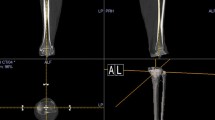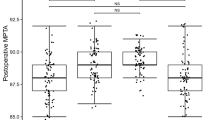Abstract
Purpose
The accuracy of patient-specific instrumentation (PSI) in total knee arthroplasty (TKA) is still controversial, especially in the tibial prosthesis. It was hypothesized that the design modification of PSI improved the tibial prosthetic alignment and reduced the associated complications. The aim of this study was to compare the accuracy of a conventional PSI with that of a newly designed PSI for total knee arthroplasty (TKA) using a new three-dimensional (3D) measurement method.
Methods
Thirty TKAs each using the conventional and newly designed PSIs were studied. The postoperative 3D-computed tomography (3D CT) image was superimposed on the preoperative 3D CT plan. The absolute differences in the tibial prosthetic alignment between the preoperative and postoperative 3D CT images were directly measured in the coronal, sagittal, and axial planes. Knees in which the difference in the prosthetic alignment was > 3° were considered deviations.
Results
The new PSI showed less mean absolute differences and lower rate of deviations than the conventional PSI in the coronal and axial planes (p = 0.045 and p = 0.004, respectively). The deviations (> 3°) of the tibial prosthesis using the conventional PSI were 27, 30, and 63% and of those using the new PSI were 0, 20, and 20% in the coronal, sagittal, and axial planes, respectively.
Conclusions
This is the first report to evaluate the effect of improvement in PSI design on the postoperative alignment using 3D method, and it clearly showed that the modification significantly improved the accuracy of alignment and reduced the deviations.
Level of evidence
Therapeutic study, case–control study, Level III.
Similar content being viewed by others
References
Abdel MP, Parratte S, Blanc G, Ollivier M, Pomero V, Viehweger E et al (2014) No benefit of patient-specific instrumentation in TKA on functional and gait outcomes: a randomized clinical trial. Clin Orthop Relat Res 472:2468–2476
Abdel MP, von Roth P, Hommel H, Perka C, Pfitzner T (2015) Intraoperative navigation of patient-specific instrumentation does not predict final implant position. J Arthroplasty 30:564–566
Anderl W, Pauzenberger L, Kolblinger R, Kiesselbach G, Brandl G, Laky B et al (2016) Patient-specific instrumentation improved mechanical alignment, while early clinical outcome was comparable to conventional instrumentation in TKA. Knee Surg Sports Traumatol Arthrosc 24:102–111
Boonen B, Schotanus MG, Kerens B, van der Weegen W, van Drumpt RA, Kort NP (2013) Intra-operative results and radiological outcome of conventional and patient-specific surgery in total knee arthroplasty: a multicentre, randomised controlled trial. Knee Surg Sports Traumatol Arthrosc 21:2206–2212
Boonen B, Schotanus MG, Kort NP (2012) Preliminary experience with the patient-specific templating total knee arthroplasty. Acta Orthop 83:387–393
Chen JY, Yeo SJ, Yew AK, Tay DK, Chia SL, Lo NN et al (2014) The radiological outcomes of patient-specific instrumentation versus conventional total knee arthroplasty. Knee Surg Sports Traumatol Arthrosc 22:630–635
Fang DM, Ritter MA, Davis KE (2009) Coronal alignment in total knee arthroplasty: just how important is it? J Arthroplasty 24:39–43
Faul F, Erdfelder E, Lang AG, Buchner A (2007) G*Power 3: a flexible statistical power analysis program for the social, behavioral, and biomedical sciences. Behav Res Methods 39:175–191
Fu Y, Wang M, Liu Y, Fu Q (2012) Alignment outcomes in navigated total knee arthroplasty: a meta-analysis. Knee Surg Sports Traumatol Arthrosc 20:1075–1082
Hafez MA, Chelule KL, Seedhom BB, Sherman KP (2006) Computer-assisted total knee arthroplasty using patient-specific templating. Clin Orthop Relat Res 444:184–192
Hirschmann MT, Konala P, Amsler F, Iranpour F, Friederich NF, Cobb JP (2011) The position and orientation of total knee replacement components: a comparison of conventional radiographs, transverse 2D-CT slices and 3D-CT reconstruction. J Bone Jt Surg Br 93:629–633
Howell SM, Kuznik K, Hull ML, Siston RA (2008) Results of an initial experience with custom-fit positioning total knee arthroplasty in a series of 48 patients. Orthopedics 31:857–863
Jiang J, Kang X, Lin Q, Teng Y, An L, Ma J et al (2015) Accuracy of patient-specific instrumentation compared with conventional instrumentation in total knee arthroplasty. Orthopedics 38:e305–e313
Kim YH, Kim JS, Yoon SH (2007) Alignment and orientation of the components in total knee replacement with and without navigation support: a prospective, randomised study. J Bone Jt Surg Br 89:471–476
Kuriyama S, Hyakuna K, Inoue S, Tamaki Y, Ito H, Matsuda S (2014) Tibial rotational alignment was significantly improved by use of a CT-navigated control device in total knee arthroplasty. J Arthroplasty 29:2352–2356
Kwon OR, Kang KT, Son J, Suh DS, Heo DB, Koh YG (2017) Patient-specific instrumentation development in TKA: 1st and 2nd generation designs in comparison with conventional instrumentation. Arch Orthop Trauma Surg 137:111–118
Lee YS, Lee BK, Lee SH, Park HG, Jun DS, do Moon H (2013) Effect of foot rotation on the mechanical axis and correlation between knee and whole leg radiographs. Knee Surg Sports Traumatol Arthrosc 21:2542–2547
Leeuwen JA, Grogaard B, Nordsletten L, Rohrl SM (2015) Comparison of planned and achieved implant position in total knee arthroplasty with patient-specific positioning guides. Acta Orthop 86:201–207
Liu HX, Shang P, Ying XZ, Zhang Y (2016) Shorter survival rate in varus-aligned knees after total knee arthroplasty. Knee Surg Sports Traumatol Arthrosc 24:2663–2671
Lombardi AV Jr, Berend KR, Ng VY (2011) Neutral mechanical alignment: a requirement for successful TKA: affirms. Orthopedics 34:e504–e506
Marimuthu K, Chen DB, Harris IA, Wheatley E, Bryant CJ, MacDessi SJ (2014) A multi-planar CT-based comparative analysis of patient-specific cutting guides with conventional instrumentation in total knee arthroplasty. J Arthroplasty 29:1138–1142
Matsuda S, Miura H, Nagamine R, Urabe K, Hirata G, Iwamoto Y (2001) Effect of femoral and tibial component position on patellar tracking following total knee arthroplasty: 10-year follow-up of Miller-Galante I knees. Am J Knee Surg 14:152–156
Maus U, Marques CJ, Scheunemann D, Lampe F, Lazovic D, Hommel H et al (2018) No improvement in reducing outliers in coronal axis alignment with patient-specific instrumentation. Knee Surg Sports Traumatol Arthrosc 26:2788–2796
Mizu-Uchi H, Matsuda S, Miura H, Higaki H, Okazaki K, Iwamoto Y (2009) Three-dimensional analysis of computed tomography-based navigation system for total knee arthroplasty: the accuracy of computed tomography-based navigation system. J Arthroplasty 24:1103–1110
Murakami AM, Hash TW, Hepinstall MS, Lyman S, Nestor BJ, Potter HG (2012) MRI evaluation of rotational alignment and synovitis in patients with pain after total knee replacement. J Bone Jt Surg Br 94:1209–1215
Nicoll D, Rowley DI (2010) Internal rotational error of the tibial component is a major cause of pain after total knee replacement. J Bone Jt Surg Br 92:1238–1244
Okamoto S, Mizu-Uchi H, Okazaki K, Hamai S, Tashiro Y, Nakahara H et al (2016) Two-dimensional planning can result in internal rotation of the femoral component in total knee arthroplasty. Knee Surg Sports Traumatol Arthrosc 24:229–235
Parratte S, Blanc G, Boussemart T, Ollivier M, Le Corroller T, Argenson JN (2013) Rotation in total knee arthroplasty: no difference between patient-specific and conventional instrumentation. Knee Surg Sports Traumatol Arthrosc 21:2213–2219
Silva A, Sampaio R, Pinto E (2014) Patient-specific instrumentation improves tibial component rotation in TKA. Knee Surg Sports Traumatol Arthrosc 22:636–642
Thienpont E, Schwab PE, Fennema P (2017) Efficacy of patient-specific instruments in total knee arthroplasty: a systematic review and meta-analysis. J Bone Jt Surg Am 99:521–530
Vince KG (2012) The stiff total knee arthroplasty: causes and cures. J Bone Jt Surg Br 94:103–111
Wasielewski RC, Galante JO, Leighty RM, Natarajan RN, Rosenberg AG (1994) Wear patterns on retrieved polyethylene tibial inserts and their relationship to technical considerations during total knee arthroplasty. Clin Orthop Relat Res 299:31–43
Yamamura K, Minoda Y, Mizokawa S, Ohta Y, Sugama R, Nakamura S et al (2017) Novel alignment measurement technique for total knee arthroplasty using patient specific instrumentation. Arch Orthop Trauma Surg 137:401–407
Author information
Authors and Affiliations
Corresponding author
Ethics declarations
Conflict of interest
Author YM has received research Grants and speaker honorarium from MicroPort.
Ethical approval
This study was approved by the institutional review board of Osaka City University Graduate School of Medicine and Faculty of Medicine (ID number 1992).
Informed consent
All patients provided informed consent.
Additional information
Publisher's Note
Springer Nature remains neutral with regard to jurisdictional claims in published maps and institutional affiliations.
Rights and permissions
About this article
Cite this article
Yamamura, K., Minoda, Y., Sugama, R. et al. Design improvement in patient-specific instrumentation for total knee arthroplasty improved the accuracy of the tibial prosthetic alignment in the coronal and axial planes. Knee Surg Sports Traumatol Arthrosc 28, 1560–1567 (2020). https://doi.org/10.1007/s00167-019-05571-7
Received:
Accepted:
Published:
Issue Date:
DOI: https://doi.org/10.1007/s00167-019-05571-7











